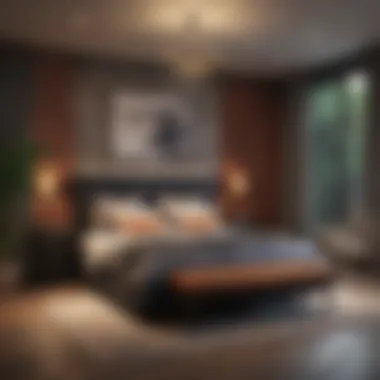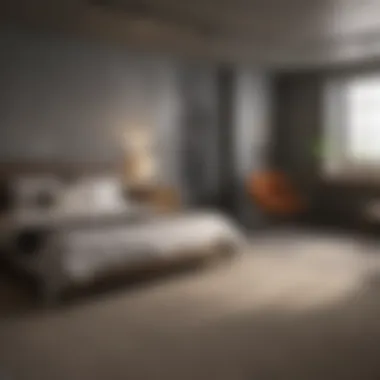Transforming Your Basement into a Stylish Bedroom


Intro
Transforming a basement into a bedroom can be a rewarding endeavor. This process not only maximizes usable space but can also enhance property value. However, it demands careful planning and consideration of various factors, including legal requirements, moisture control, and optimal design strategies. Homeowners and renters alike can benefit from this guide, which aims to provide a systematic approach to creating an inviting and functional bedroom in an often overlooked area of the home.
Current Trends
Color Palettes
In recent years, there has been a significant shift towards soft neutrals and earthy tones. Colors like taupe, sage green, and soft gray are highly sought after. These shades create a calming atmosphere, making them ideal for a bedroom. Bright whites can also be effective, offering a crisp, clean backdrop against which to showcase decor.
Popular Styles
Basement bedrooms are falling into several trending categories:
- Modern Minimalism: Characterized by clean lines and limited decor. This style promotes a clutter-free environment that feels spacious.
- Industrial Chic: Exposed beams, concrete finishes, and vintage furnishings. This aesthetic can turn a basic basement into a unique living space.
- Cozy Retreat: Layered textiles, warm colors, and inviting lighting create a cozy ambiance, making the basement feel like a true retreat.
"Designing a space in a basement requires creativity. Utilizing existing elements can lead to surprising and captivating results." - Interior Design Expert
Visual Ideas
Gallery of Styled Bedrooms
To inspire and inform your design choices, consider these visual concepts:
- Monochromatic Themes: Using varying shades of the same color scheme can create depth and interest.
- Statement Wall: Install wallpaper or paint one wall a bold color to provide a focal point.
- Multi-functional Furniture: Look for beds with drawers or sofas that convert into beds.
Before-and-After Transformations
Keep in mind that many successful projects began as simple spaces:
- A simple, dingy basement can become a sophisticated bedroom with the right color choices and furniture arrangements.
- Adding large windows or a well-planned lighting scheme can dramatically change how the space is perceived.
By understanding current trends in color and style, and examining effective visual strategies, you open the door to a successful basement transformation. This guide will serve to highlight the multifaceted aspects of planning, designing, and constructing a basement bedroom, providing an informed pathway to your ideal space.
Understanding the Basics of Basement Bedrooms
Creating a bedroom in a basement can be an innovative way to add space to your home. However, it is crucial to grasp the foundational aspects that define what makes a basement bedroom functional and appealing. This understanding serves not only to meet practical requirements but also enhances the overall living experience.
A basement bedroom is more than just a room with walls and a bed. It involves a thoughtful approach to space planning, comfort, and compliance with safety standards. When properly executed, a basement bedroom can be a serene retreat or a vibrant living space, capable of meeting the personal needs of residents.
Defining Basement Bedroom Requirements
Before engaging in any renovation work, it is essential to establish what constitutes a legal and functional basement bedroom.
- Minimum Ceiling Heights: Local regulations often set minimum ceiling height requirements, typically around 7 feet. This helps ensure adequate space and comfort for occupants.
- Egress Windows: Safety is paramount. An egress window allows for safe exits in emergencies, often a requirement in building codes. Ensure these windows are properly sized and positioned to meet local standards.
- Ventilation: A basement can easily trap moisture and air pollutants. Proper airflow needs to be maintained through windows, vents, or mechanical systems to keep the bedroom healthy.
- Heating: Basements can be colder than other parts of the home, so having sufficient heating is necessary. Consider options like baseboard heating or installing a mini-split system for comfort.
Understanding these requirements will streamline your renovation and ensure the space functions effectively and safely.
Assessing Local Building Codes
Navigating local building codes is critical when transforming your basement into a bedroom. These regulations are designed to ensure the safety and suitability of living spaces.
- Research Local Codes: Check with your local building authority or municipality. Each area has specific regulations regarding basement bedrooms, including size, safety features, and requirements.
- Permits: Before starting your project, secure the necessary permits. Not doing so can lead to fines or complications in insuring your new bedroom.
- Consult Professionals: It may be beneficial to hire an architect or a contractor familiar with local codes. Their expertise can help navigate the nuances of the law and enhance compliance.
- Documentation: Keep thorough records of all permits, inspections, and correspondence with local authorities. This documentation could be valuable should any issues arise later.
Understanding and complying with local building codes will protect you, your investment, and ensure a successful renovation, transforming an underutilized basement into a livable bedroom.
Planning Your Basement Bedroom
Planning a basement bedroom is a critical endeavor that lays the groundwork for creating a functional living space. This process entails more than just selecting furniture or deciding on decor. It often involves evaluating structural aspects, assessing existing conditions, and understanding how best to allocate your available space.
When planning, one key element is determining the room’s layout and flow. Understanding how people will navigate through the room can influence decisions about placement of beds, wardrobes, and accommodations for natural light.
Additionally, planning allows homeowners to maximize the utility of the space. A well-thought-out plan ensures that every square foot is used optimally, making a small area appear larger and more functional. Creating a list of priorities can help avoid impulse decisions that may lead to an inefficient or overcrowded environment.
There are also benefits to organizing your thoughts during this phase. You avoid future costly mistakes that stem from rushed decisions. The planning stage serves as a comprehensive blueprint that guides you through the renovation, making it ultimately more manageable.
Evaluating Space and Layout
The evaluation of space and layout should be one of the first steps taken. Consider how the existing dimensions of the basement area align with your needs for a bedroom. Start by measuring the overall area and identifying potential obstacles, like pillars, beams, or low ceilings that might restrict the design.
Draw a scaled floor plan to visualize the room's potential. Identify where windows and doors are located. This improves your understanding of how the layout can accommodate bed placements and movement. Key aspects to consider involve:
- Bed Placement: The bed is the focal point of the bedroom. Ensure it is in a position that allows for easy access and complements the flow of the room.
- Access to Natural Light: If there are windows present, consider how to orient your bed or sitting areas to take advantage of this.
- Storage Solutions: Efficient storage may require clever placement. Built-in options can save space and provide a streamlined look.


Establishing a Budget
Once space and layout are evaluated, establishing a budget becomes necessary. A clear financial plan ensures you remain within limits and do not overspend on materials or services. The budget should account for various factors:
- Materials and Finishes: Research the costs associated with insulation, flooring, and sheetrock. Different materials have different price points and longevity.
- Labor: If you plan to hire contractors, obtain several quotes. Reliable professionals will guide the project effectively but at a price.
- Permits and Inspections: Local building regulations often require permits, and these can have associated fees. Be sure to include these in the budget.
- Contingency Fund: It's wise to set aside an additional 10-20% of the budget for unexpected expenses. Renovations can often reveal hidden issues that need immediate attention.
Having a well-planned budget provides a clear framework and a smoother experience as you transition into the construction phase. Setting financial priorities is as important as deciding on the aesthetic of the space.
"Planning is bringing the future into the present so that you can do something about it now."
By honing in on these aspects, you will find yourself prepared not just to remodel but to create a comfortable, lively basement bedroom.
Design Considerations for a Basement Bedroom
Designing a basement bedroom involves more than aesthetics; it's about creating a functional, comfortable, and inviting space. The nuances of a basement environment demand careful thought to optimize the area while maintaining visual appeal. Considerations include lighting, layout, and material choices. By addressing these elements, homeowners can effectively transform a typically overlooked space into a refreshing bedroom retreat.
Choosing the Right Aesthetic
Selecting an aesthetic for your basement bedroom sets the tone for the entire space. This choice should cater to personal taste while harmonizing with the rest of the home. Popular styles range from minimalist to cozy, industrial to contemporary. Selecting a cohesive color palette can enhance the design, making the room feel larger.
Consider the following points when deciding on your aesthetic:
- Personal Preferences: Reflect your personal style through colors, furnishings, and decor.
- Space Constraints: Aim for designs that emphasize vertical space. Mirrors can help achieve this by adding depth.
- Comfort Factors: Choose soft textures for bedding and curtains to create a warm ambiance.
- Functional Layouts: Arrange furniture to encourage flow while ensuring accessibility within the room.
Incorporating Natural Light
Natural light plays a significant role in the design of a basement bedroom. Often, basement spaces are lit with artificial sources, which can feel cramped. Integrating options for natural illumination is essential for enhancing the room's atmosphere.
Here are some strategies to consider:
- Window Additions: If feasible, creating additional windows can introduce more daylight.
- Light Wells: These structures can help bring natural light into the space from above.
- Translucent Window Treatments: Use sheer materials to allow light while maintaining privacy.
- Light Colors: Opt for lighter hues on walls and furnishings to reflect more light and make the space feel airy.
Selecting Appropriate Materials
Material choice impacts both durability and design in a basement bedroom. Both functional and aesthetic materials can help tackle common issues such as moisture and insulation.
Focus on these material considerations:
- Moisture-Resistant Materials: Use treated wood and mold-resistant paint to guard against humidity.
- Durable Flooring: Choose flooring like ceramic tiles or vinyl that resist moisture and provide comfort.
- Insulated Materials: Proper insulation will benefit both temperature control and energy efficiency in the space.
- Textured Fabrics: Soft furnishings made from high-quality materials enhance comfort while also providing warmth.
Remember: Proper material selection can drastically enhance the sustainability and longevity of your basement bedroom, making the investment worthwhile.
Ventilation and Moisture Control
In any basement conversion project, addressing ventilation and moisture control is essential. These factors directly impact the comfort level and overall health of the living space. Basements are typically prone to dampness and poor air circulation, which can lead to a range of issues, from mold growth to unpleasant odors. This section will explore the significance of proper ventilation and moisture management.
Understanding Basement Humidity Issues
Basements often encounter high humidity levels due to their positioning below ground. This can create a somewhat inhospitable environment, especially during the warmer months. High moisture levels are not ideal for a bedroom as it can damage furniture, promote mold, and create discomfort.
There are several common sources of humidity in basements:
- Groundwater intrusion: Water seepage from outside can significantly affect indoor humidity.
- Condensation: Warmer air meeting cold surfaces leads to moisture buildup on walls and pipes.
- Poor drainage: Ineffective drainage systems can further exacerbate water issues.
Maintaining a balanced humidity level is vital. The recommended indoor humidity level is between 30% and 50%. If humidity consistently exceeds this range, it can result in various problems, such as:
- Health issues from mold exposure
- Damage to drywall and flooring
- Compromised air quality affecting sleep and comfort
Implementing Effective Ventilation Systems
To combat humidity issues, proper ventilation systems must be put in place. These systems should promote airflow, ensuring that moist air escapes while fresh air enters. There are several strategies that can be employed to achieve effective ventilation in a basement bedroom:
- Natural Ventilation: If possible, create openings in windows to facilitate airflow. Ensure that windows are operable and strategically placed to encourage a cross-breeze.
- Exhaust Fans: Install exhaust fans in areas prone to moisture, such as bathrooms and laundry rooms. These can help remove humid air and reduce overall moisture levels in the bedroom space.
- Dehumidifiers: Consider using a dehumidifier to control humidity levels, especially during hot and humid months. This device will collect excess moisture from the air, helping maintain a healthier environment.
- Air Exchanges Systems: Systems such as heat recovery ventilators (HRVs) or energy recovery ventilators (ERVs) can be efficient solutions. They exchange stale indoor air for fresh outdoor air while recovering heat from the outgoing air, thereby improving energy efficiency.
- Ducted Ventilation: If feasible, connect the basement to the home’s existing HVAC system. This ensures that conditioned air flows into the basement and maintains consistent temperature and humidity levels.
Tip: Regularly check and maintain your ventilation systems and devices to ensure optimal performance. A well-ventilated basement can transform the space into an inviting, comfortable bedroom.
By addressing these ventilation needs proactively, homeowners can significantly enhance the livability of basement bedrooms while safeguarding against moisture-related issues.
Insulation and Energy Efficiency
Insulation and energy efficiency are crucial aspects when converting a basement into a bedroom. Proper insulation not only keeps the space comfortable throughout different seasons but also plays a significant role in energy conservation. An insulated basement bedroom can help maintain a consistent temperature, reducing the need for excessive heating or cooling, which ultimately leads to lower energy bills. Furthermore, effective insulation minimizes the risk of moisture infiltration, preventing potential damage to both the structure and the interior.
Types of Insulation for Basements
Various types of insulation are suitable for basement applications, each with its unique benefits:


- Fiberglass Insulation: This is a popular choice due to its affordability and availability. It typically comes in batts or rolls and can be installed between wall studs. However, it is crucial to ensure that it remains dry, as moisture can lead to mold growth.
- Foam Board Insulation: Another effective option, foam board insulation provides a high R-value per inch, which means better thermal resistance. It can be applied on walls and helps in reducing thermal bridging.
- Spray Foam Insulation: This type expands on application, filling gaps and creating an airtight seal. It effectively minimizes air leakage and is excellent for hard-to-reach areas, although it is generally more expensive.
- Mineral Wool (Rock Wool): Resistant to fire and water, mineral wool serves as both insulation and a sound barrier. It provides some moisture resistance, making it suitable for basements.
In choosing the right type of insulation, consider factors such as your local climate, budget, and the existing structure of the basement. Each material has its pros and cons, and sometimes a combination of these insulations may provide the best results.
Enhancing Energy Efficiency
Enhancing energy efficiency in your basement bedroom involves more than just insulation. Here are several strategies:
- Air Sealing: Gaps around windows, doors, and foundation walls should be sealed to prevent drafts. Using caulk or weather stripping is highly effective.
- Window Treatments: Double-pane windows offer better insulation than single-pane options. Consider using insulated curtains or shades to further reduce heat loss in winter and keep the space cooler in summer.
- Heating and Cooling Systems: If possible, upgrade to energy-efficient heating and cooling systems. Options like ductless heat pumps can provide efficient climate control without extensive renovations.
- Energy-Efficient Lighting: Install LED lighting, which uses significantly less energy than traditional incandescent bulbs. Additionally, using timers or smart lighting controls can help manage energy usage effectively.
Implementing these strategies not only improves comfort but also increases the overall value of the property. An energy-efficient basement bedroom can be an attractive feature for potential buyers or renters, making it a worthy investment in any home renovation project.
It is recommended to consult with a professional when undertaking significant insulation and energy efficiency upgrades to ensure that all installations meet required standards and are performed correctly.
Electrical and Plumbing Considerations
When transforming a basement into a bedroom, addressing electrical and plumbing needs is crucial. These considerations impact not only the safety and functionality of the space but also contribute to the overall comfort and aesthetic appeal. Without proper planning in these areas, one might face significant issues later, such as inadequate lighting or improper plumbing that hinders daily activities. This section will explore how to manage electrical systems, the importance of lighting, and the basic plumbing requirements for a basement bedroom.
Installing Adequate Lighting
Proper lighting is essential for any living space, especially in a basement where natural light is often limited. Inadequate lighting can create a dark and uninviting environment. Here are several key points to consider when installing lighting:
- Layered Lighting: A combination of ceiling lights, task lights, and accent lights creates a well-lit room. This approach provides versatility and can enhance the room's design.
- Fixture Placement: Lights should be placed strategically to illuminate areas where activities will occur. For example, consider placing brighter fixtures over reading corners or workspaces.
- Dimming Options: Installing dimmers can allow for adjustable lighting intensity, making the space more functional for various activities. It also enables homeowners to set the mood—bright for work, soft for relaxation.
Proper lighting can significantly transform the ambiance of a basement bedroom, making it more inviting and functional.
Upgrading Electrical Systems
Basement bedrooms may require significant upgrades to existing electrical systems. Outdated systems can pose safety risks and limit the functionality of the room. Consider these aspects when upgrading:
- Electrical Outlets: Add enough outlets to support modern electronics and appliances. It’s advisable to install outlets near beds and workspaces to avoid excessive usage of extension cords.
- Circuit Load: Determine the electrical load of the new bedroom. A professional electrician can ensure that the circuit can handle the demand from lighting, heating, and any other electrical devices.
- Compliance with Codes: Ensure compliance with local building codes when upgrading. This might include updating the existing service panel or ensuring all wiring is up to current standards.
Plumbing Needs for Basement Bedrooms
If the basement bedroom will have an attached bathroom or wet bar, plan for plumbing installation carefully. Here are essential plumbing considerations:
- Waste and Vent Pipes: Installing waste and vent pipes is necessary for bathrooms. Make sure they are placed correctly to avoid clogs and ensure proper drainage.
- Water Supply Lines: If adding a bathroom, lay out water supply lines beforehand and ensure there is sufficient pressure for all fixtures.
- Preventing Water Issues: Because basements are prone to moisture issues, waterproofing and proper drainage systems are critical to prevent leaks and water damage.
When planning for electrical and plumbing needs, it is advisable to consult with qualified professionals. This ensures safety compliance and enhances the room’s overall functionality.
Decorating Your Basement Bedroom
Decorating your basement bedroom is a crucial step in the overall transformation of this often-overlooked space. The process involves not just aesthetics but also functionality and comfort. A well-decorated bedroom can elevate the mood of the room, making it feel inviting and warm. Thoughtful design can help you maximize the potential of the area, creating a retreat within your home that is uniquely yours. With the right approach to decorating, you can combine design elements in a way that reflects your personal style while meeting practical needs.
Selecting Furniture and Layout
The first decision when decorating a basement bedroom is the choice of furniture. Since basements tend to have unique layouts, it’s essential to measure the space accurately before purchasing any items. Choosing the right size and type of furniture can create a harmonious balance in the room. Opt for multi-functional furniture, such as a bed with storage underneath or a sofa bed, to save space and enhance utility. The layout should facilitate smooth movement while maintaining cozy intimacy.
A well-planned arrangement encourages a clutter-free environment. Here are some factors to consider:
- Scale: Ensure the scale of the furniture matches the room size.
- Purpose: Think about how you plan to use the space, whether for sleeping, studying, or relaxing.
- Flow: Allow for easy navigation by adequately spacing out furniture items.
Choosing Color Schemes
Color plays a vital role in setting the mood of any room. For basement bedrooms, where natural light may be limited, it is advisable to choose lighter hues. Soft whites, pastels, and light grays can help to brighten the space, making it feel larger and more open. If a warmer touch is desired, earth tones such as soft browns or muted greens can add coziness without feeling overwhelming.
Consider the following when selecting a color scheme:
- Energy: Different colors evoke different feelings, so choose based on the atmosphere you wish to create.
- Cohesion: Ensure that the color scheme works well with adjoining spaces.
- Accent Walls: Adding an accent wall in a bolder color can create a focal point without overwhelming the entire space.
Incorporating Artwork and Accessories
Art and accessories are what truly bring a space to life. They reflect your personality and offer a chance to express creativity. Use artwork to inject vibrant colors or captivating themes that speak to your taste. Selecting accessories that resonate with your personality can make the room feel more like home. Consider items like decorative pillows, rugs, or wall-mounted shelves that can serve both functional and aesthetic purposes.
Some suggestions for selecting artwork and accessories include:
- Personal Touch: Choose pieces that have personal significance or evoke positive memories.
- Variety: Mix different types of artwork, such as photographs, paintings, and sculptures, to create visual interest.
- Balance: Aim for a good balance between empty space and decoration to avoid a crowded feel.
"A well-decorated space is a reflection of who you are and can significantly enhance the way you feel in your home."
Overall, the process of decorating a basement bedroom requires careful consideration of furniture selection, color schemes, and artwork. With attention to detail and thoughtful choices, a basement can turn into a beautifully designed, functional living area.
Potential Challenges and Solutions


When transforming a basement into a comfortable bedroom, several potential challenges could impede the renovation process. Identifying these challenges early on is crucial. This allows homeowners to prepare and implement effective solutions to ensure a smooth project flow. Not only does addressing these challenges enhance the final result, but it also fosters a sense of comfort and functionality in the space. Each issue presents unique considerations, making it essential to explore them thoroughly.
Dealing with Low Ceilings
One common challenge in basement renovations is low ceilings. Many basements are not designed with high ceilings, which can create a cramped atmosphere. To mitigate this, homeowners can consider several approaches. First, be sure to measure the ceiling height accurately. If it is 7 feet or less, this may pose a problem.
Another solution involves selecting lighter paint colors for the ceiling. Light hues can provide an illusion of height, making the room appear more spacious. Additionally, vertical lighting fixtures or wall-mounted sconces can help draw the eye upward, thereby enhancing the visual height of the room.
A practical consideration is to minimize bulk-headed elements. Avoiding excessively large ceiling beams might contribute to better flow. Sometimes homeowners opt for a drop ceiling; however, this should be approached with caution, as it can further reduce available height. Instead, consider whether ductwork can be rerouted or if it needs to be boxed in at all.
Managing Noise Levels
Noise control is another significant concern when creating a basement bedroom. Depending on the home’s structure, sound from above floors may be transmitted downwards, disrupting rest. Implementing soundproofing measures is essential. This can be achieved through various methods.
Use insulation batts made specifically for sound absorption in walls and ceilings. Adding mass-loaded vinyl can also dampen noise levels effectively. Carpeting is another way to lessen sound transmission, especially if the floor is concrete. Properly placed furniture can absorb some sound as well.
Moreover, identifying specific times when noise is likely to occur can help you prepare. For instance, if children are home in the afternoons, it might be beneficial to have set quiet hours for the bedroom.
Addressing Natural Light Deficiency
Basements often struggle with natural light due to their placement below ground level. Insufficient light can give a space a dark and uninviting feel. To resolve this, creative solutions can be employed.
Incorporating mirrors strategically can reflect light and make the room feel brighter. Positioning large mirrors opposite any light sources can amplify brightness significantly.
Another method is to explore innovative lighting options. Installing recessed lighting or wall sconces can provide ample artificial illumination. Considering light fixtures with adjustable brightness is also an effective way to address light needs.
If available, window wells can be expanded to allow more natural light in. Adding larger windows, if local building codes permit, could also enhance light intake and ventilation. Furthermore, ensure the color palette complements the light sources. Using soft, warm tones can create a cozy mood, making a basement bedroom feel lighter and more inviting.
Successfully addressing these challenges not only improves the functionality of a basement bedroom but also elevates its overall comfort and aesthetic appeal.
Maximizing Functionality and Comfort
Maximizing functionality and comfort is essential in transforming your basement into a welcoming bedroom. This space often suffers from constraints such as limited natural light and lower ceilings. However, well-thought-out designs can enhance usability and create an inviting atmosphere. Prioritizing these aspects leads to effective space utilization, ensuring that the bedroom does more than just serve as a sleeping area.
When planning a basement bedroom, you must consider how to make the most of every square foot. Designing multi-functional areas can significantly increase the space's practicality. There are several benefits:
- Versatility: The ability to adapt the space for various uses increases its value.
- Organization: Multi-functional designs help eliminate clutter and promote a clean, orderly environment.
- Comfort: A well-arranged space contributes to a more comfortable living experience.
In summary, maximizing functionality and comfort becomes a pivotal aspect of your basement bedroom project. It ensures that the end result meets your needs and provides a cozy retreat.
Creating Multi-Functional Spaces
Creating multi-functional spaces in your basement bedroom allows efficient use of space while fulfilling various needs. You can merge living quarters with a home office, exercise area, or even a guest space. To achieve this:
- Use multi-purpose furniture. For example, a daybed can function as both a sofa and a bed.
- Arrange the layout to include adaptable areas. A desk can double as a nightstand in a tight layout.
- Consider foldable or stackable furniture to offer flexibility. You can hide additional seating or work surfaces when they are not in use.
Effective zoning in your bedroom can help. Define each section's purpose without sacrificing style. This can be achieved through rugs, lighting, or furniture arrangement.
Incorporating Storage Solutions
Incorporating storage solutions is crucial to maintaining an organized basement bedroom. Given space constraints, effective storage can help minimize clutter and ensure every item has its designated area. Here are some considerations:
- Built-in storage: Utilize under-stair areas or the space above the ceiling. Custom cabinetry can maximize every inch.
- Vertical storage: Shelving units that reach the ceiling can house books or decorative items, freeing up floor space.
- Multi-functional storage: Ottomans with hidden compartments or beds with drawers can provide additional storage without occupying more space.
The right storage solutions not only keep your basement bedroom organized but also enhance functionality. This ensures the space remains comfortable and inviting.
Effective design integrates storage seamlessly, making the space feel larger and more livable while preventing clutter.
Through thoughtful design and arrangement, you can maximize both functionality and comfort in your basement bedroom. The result will be a versatile and attractive space that truly serves your needs.
Finalizing Your Basement Bedroom Project
Finalizing the basement bedroom project is a critical step. This phase ensures that your hard work results in a comfortable and safe living space. It requires careful attention to detail, as well as adherence to safety standards and personal preferences. Proper finalization can vastly enhance the functionality and aesthetics of the room.
Conducting Final Inspections
Before officially moving in, conducting final inspections is essential. This involves checking every aspect of the room to ensure it meets building codes and personal standards.
- Structural Integrity: Verify that walls, floors, and ceilings were built correctly and safely.
- Electrical Systems: Ensure all electrical outlets, switches, and fixtures are functioning properly. This includes checking for any exposed wiring, which can be a fire hazard.
- Plumbing: If there are any bathroom facilities, inspect for leaks or malfunctions. Testing all faucets and toilets is wise.
- HVAC and Insulation: Make sure that heating, ventilation, and air conditioning systems work effectively to control the climate of the basement and assess whether insulation meets energy efficiency standards.
Do not rush through this process. If problems arise, address them immediately to avoid complications later. Taking time to ensure every detail is right can save you headaches down the line.
Preparing for Move-In Day
Once inspections are passed, it is time to prepare for move-in day. This is an exciting phase that requires organization and planning.
- Cleaning: Give the space a thorough clean. Dust all surfaces, vacuum floors, and remove any construction debris left behind.
- Organizing: Plan the arrangement of furniture in advance. Consider layout and accessibility. Having a blueprint can streamline this process.
- Essential Items: On moving day, ensure essential furnishings like a bed, basic kitchen items, and necessary utilities are set up first. Plan for what you will need immediately versus what can wait.
- Final Touches: After the big items are in place, personalize your space. Add decorative elements such as artwork, throw pillows, or personal items that make it feel like home.
Proper preparation for move-in day can transform a daunting task into a smooth transition. Organization is key.
With careful inspections and planning, you will not only finalize the project but also ensure that the basement bedroom you created meets your expectations and needs. This thoughtful approach can result in a pleasant living space that serves your requirements well.



